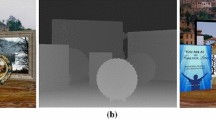Abstract
Digital image inpainting (DII) is a computer algorithm that restores missing information of images such as those of old oil paintings. This problem occurs in human visual systems as well: we have blind spots (BS), but we see natural patterns in the BS region. This article presents the computational identity between the DII algorithm and the vision model for the filling-in process at the BS. Based on physiological evidence and conjecture, we define an evaluation function that evaluates the quality of filled-in (or inpainted) images. The definition of the evaluation function helps the original DII algorithm to improve the convergence speed. Numerical experiments demonstrate that the convergence speed using the energy function is three times faster than the original DII algorithm. Results show that the resultant filled-in patterns by the visual model are comparable with those of the DII algorithm.







Similar content being viewed by others
References
Grzybowski A, Aydin P (2007) Edme Mariotte (1620–1684): pioneer of neurophysiology. Surv Ophthalmol 52(4):443–451
Bertalmio M, Sapiro G, Caselles V, Ballester C (2000) Image inpainting. Proc SIGGRAPH 2000:417–424
Komatsu H (2006) The neural mechanisms of perceptual filling-in. Nat Rev Neurosci 7:200–231
Matsumoto M, Komatsu H (2005) Neural responses in the Macaque V1 to bar stimuli with various lengths presented on the blind spot. J Neurophys 93(5):2374–2387
Satoh S, Usui S (2008) Computational theory and applications of a filling-in process at the blind spot. Neural Netw 21:1261–1271
Perona P, Malik J (1990) Scale–space and edge detection using anisotropic diffusion. IEEE PAMI 12:629–639
Ito M, Komatsu H (2004) Representation of Angles embedded within contour stimuli in area V2 of Macaque monkeys. J Neurosci 24(13):3313–3324
Poggio T, Torre V, Koch C (1985) Computational vision and regularization theory. Nature 317:314–319
Florack L, Romeny B, Koenderink J, Viergever M (1992) Scale and the differential structure of images. Image Vis Comput 10(6):376–388
Lindeberg T (1994) Scale–space theory in computer vision. Kluwer, The Netherlands
Polak E (1971) Computational methods in optimization. Academic Press, New York
Acknowledgments
This work was partially supported by a Grant-in-Aid for Young Scientists (#20700279) from the Ministry of Education, Culture, Sports, Science and Technology, Japan.
Author information
Authors and Affiliations
Corresponding author
Rights and permissions
About this article
Cite this article
Satoh, S. Computational identity between digital image inpainting and filling-in process at the blind spot. Neural Comput & Applic 21, 613–621 (2012). https://doi.org/10.1007/s00521-011-0646-y
Received:
Accepted:
Published:
Issue Date:
DOI: https://doi.org/10.1007/s00521-011-0646-y




